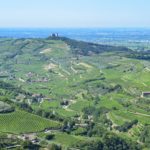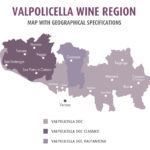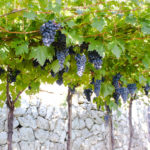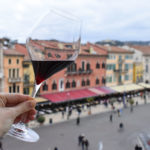Putting Valpolicella on the map
The extensive Valpolicella area fans out to the east and west of Verona, across a dozen parallel valleys running from north to south. Altogether there are around 8,600 hectares under vine, with the most famous Valpolicella Classico area lying west of Verona, wedged between the city and Lake Garda.
 Vines have grown in the area since ancient times and one theory interprets the name Valpolicella as deriving from ‘vallis polis celllae’ or ‘valley of the many cellars’ due to the historical importance of winemaking in the area.The climate and conditions are ideal for vines, with the mitigating influence of Lake Garda and its mild winds fundamental to the microclimate, keeping the vineyards ventilated and free from damp. To the north of Valpolicella the high Lessinia plateau, which reaches 1800m asl, provides protection from colder alpine air currents. In Valpolicella vines are increasingly trained to the traditional pergola system and often grown on terraces supported by dry stone walls, known here as marogne, creating a tapestry-like effect across landscapes. The Valpolicella countryside is also home to numerous olives for the delicious Valpolicella PDO extra virgin olive oil and cherry trees. In addition to the Valpolicella Classico area, the only subzone currently officially in place for Valpolicella wines is the Valpantena, just north east of the city of Verona. The remaining valleys are covered by the Valpolicella DOC denomination without subzone mentions for the time being, though work is in progress to create more official subzones for the other valleys, including Valle di Mezzane, making it easier to focus on the individual characteristics of each one.
Vines have grown in the area since ancient times and one theory interprets the name Valpolicella as deriving from ‘vallis polis celllae’ or ‘valley of the many cellars’ due to the historical importance of winemaking in the area.The climate and conditions are ideal for vines, with the mitigating influence of Lake Garda and its mild winds fundamental to the microclimate, keeping the vineyards ventilated and free from damp. To the north of Valpolicella the high Lessinia plateau, which reaches 1800m asl, provides protection from colder alpine air currents. In Valpolicella vines are increasingly trained to the traditional pergola system and often grown on terraces supported by dry stone walls, known here as marogne, creating a tapestry-like effect across landscapes. The Valpolicella countryside is also home to numerous olives for the delicious Valpolicella PDO extra virgin olive oil and cherry trees. In addition to the Valpolicella Classico area, the only subzone currently officially in place for Valpolicella wines is the Valpantena, just north east of the city of Verona. The remaining valleys are covered by the Valpolicella DOC denomination without subzone mentions for the time being, though work is in progress to create more official subzones for the other valleys, including Valle di Mezzane, making it easier to focus on the individual characteristics of each one.
 Altogether there are five municipalities within the Valpolicella Classico denomination area and 19 in the whole Valpolicella territory. The Classico zone, where nature, culture and history are the most deeply intertwined with the local wine heritage, is a stunning area with Romanesque churches, magnificent villas and delicious local cuisine that pairs perfectly with the wines.
Altogether there are five municipalities within the Valpolicella Classico denomination area and 19 in the whole Valpolicella territory. The Classico zone, where nature, culture and history are the most deeply intertwined with the local wine heritage, is a stunning area with Romanesque churches, magnificent villas and delicious local cuisine that pairs perfectly with the wines.
What to see in and around Valpolicella
The charming village of San Giorgio di Valpolicella is a must-see of Valpolicella. Perched high above the town of Sant’Ambrogio, San Giorgio has a panoramic terrace with wide open views across vineyards and hills and as far as Lake Garda on a clear day. The village has one of the area’s lovely Romanesque churches, dating from the 8th century. Others include the charming 12th century church of San Floriano at San Pietro in Cariano.
 Valpolicella is also home to stunning villas dating from various eras through history and often an integral part of the local wine estates. Ancient Roman floor mosaics dating from the third century were discovered a few years ago below the vines growing at the Azienda Benedetti La Villa estate near Negrar, a significant find, and the estate has been working with archaeologists and authorities and the estate’s wine tours can include a visit to the site to see the mosaics. The Santa Sofia winery at San Pietro in Cariano incorporates a 16th century Palladian villa while the most statuesque of the Valpolicella area’s villas is the majestic Villa Mosconi Bertani built from 1735 and owned by the Bertani winemaking family since 1957. The villa has impressive artistic decorations both inside and out, while the extensive landscape gardens, feature centuries-old trees, a lake and even a coffee house. In Fumane, Villa della Torre is another striking villa to visit or even stay at, in one of ten guest rooms. The Renaissance building features the work of famous architects including Giulio Romano and Michele Sanmichele, with perfect perspectives, a fish pond and monumental grotesque fireplaces inside. The villa and its surrounding vines are owned by the Marilisa Allegrini group and tours of the villa with tastings of the estate wines can be booked.
Valpolicella is also home to stunning villas dating from various eras through history and often an integral part of the local wine estates. Ancient Roman floor mosaics dating from the third century were discovered a few years ago below the vines growing at the Azienda Benedetti La Villa estate near Negrar, a significant find, and the estate has been working with archaeologists and authorities and the estate’s wine tours can include a visit to the site to see the mosaics. The Santa Sofia winery at San Pietro in Cariano incorporates a 16th century Palladian villa while the most statuesque of the Valpolicella area’s villas is the majestic Villa Mosconi Bertani built from 1735 and owned by the Bertani winemaking family since 1957. The villa has impressive artistic decorations both inside and out, while the extensive landscape gardens, feature centuries-old trees, a lake and even a coffee house. In Fumane, Villa della Torre is another striking villa to visit or even stay at, in one of ten guest rooms. The Renaissance building features the work of famous architects including Giulio Romano and Michele Sanmichele, with perfect perspectives, a fish pond and monumental grotesque fireplaces inside. The villa and its surrounding vines are owned by the Marilisa Allegrini group and tours of the villa with tastings of the estate wines can be booked.
Footpaths and flavours in Valpolicella
The hills of Valpolicella have some great opportunities for walkers with a network of footpaths through vineyards and on quiet country roads (see infovalpolicella.it for descriptions and maps). Just west of Valpolicella, Lake Garda offers all sorts of activities with panoramic cycle paths and, especially to the north of the lake, watersports centres. The south-west shores and attractive towns of Bardolino and Lazise are the closest spots on the lake to Valpolicella and numerous restaurants serve Valpolicella wines and local dishes such as risotto all’Amarone, braised beef, platters of local cold cuts, Monte Veronese cheeses and often lake fish too. Near the lake in central Bardolino, the Munus restaurant is owned by the Guerrieri Rizzardi wine producer family, while the farmhouse-style Tenuta Canova near Lazise, is run by the Masi winery (see below for info on both). In the Valpolicella area itself, try Locanda Buglioni for tasty typical food and a range of Buglioni’s own wines and Enoteca della Valpolicella which has an impressive wine list with many by the glass (using Coravin) and some old vintage Amarone bottles. The menu of traditional specialities includes a delicious risotto made with the local passito wine, Recioto.
And in Verona

Valpolicella is tied firmly to the city of Verona, which sits just to the south roughly midway along the series of valleys where Valpolicella wines are made. Along with world-famous sites such as the Arena – the Roman amphitheatre where the celebrated opera season takes place – and Juliet’s house (this was of course the setting for William Shakespeare’s Romeo and Juliet) Verona has an excellent selection of wine bars. Wine lovers shouldn’t miss Antica Bottega del Vino, which is owned by the Famiglie Storiche association of Amarone specialist wineries. Come for just a drink in the decorative historical interior or stay for a meal and choose from the incredible selection of 4500 wines and menu of both traditional local dishes and seafood. Other atmospheric spots in central Verona with a variety of wines, always including some local sips, are the tiny Enoteca Dal Zovo and Osteria la Mandorla which also has a choice of meatballs and veggie balls.
Wines and vines
Four distinct types of red wine are made within Valpolicella: Valpolicella DOC, a fresh young wine, Valpolicella Ripasso DOC a dry still wine made with a second fermentation using skins from Amarone production; Amarone della Valpolicella DOCG must age for at least two years (four years for Riserva versions) and grapes are partially dried, resting on racks for several months for the traditional appassimento technique before fermentation, a method which is currently a candidate for UNESCO World Heritage status and Recioto della Valpolicella DOCG involves the same technique for a luscious sweet wine considered the predecessor of dry Amarone.
 All the Valpolicella wines are made with the same grape varieties, that is a blend based on local grapes Corvina and Corvinone, with at least a small percentage of Rondinella (5-30% of the blend). Other local varieties may also be included such as Molinara, fresh, light and pale in colour, and Oseleta, which is quite the opposite, intense, deeply red and adds a concentrated quality to blends. With such a spectrum of options, the characteristics of each individual wine can vary greatly and many producers make several versions of Valpolicella and Amarone. Today’s trends for lighter wines has led to a move away from the powerhouse blends of the past, even for Amarone, with more slender, elegant and fresh wines being made and lower service temperatures advised.
All the Valpolicella wines are made with the same grape varieties, that is a blend based on local grapes Corvina and Corvinone, with at least a small percentage of Rondinella (5-30% of the blend). Other local varieties may also be included such as Molinara, fresh, light and pale in colour, and Oseleta, which is quite the opposite, intense, deeply red and adds a concentrated quality to blends. With such a spectrum of options, the characteristics of each individual wine can vary greatly and many producers make several versions of Valpolicella and Amarone. Today’s trends for lighter wines has led to a move away from the powerhouse blends of the past, even for Amarone, with more slender, elegant and fresh wines being made and lower service temperatures advised.